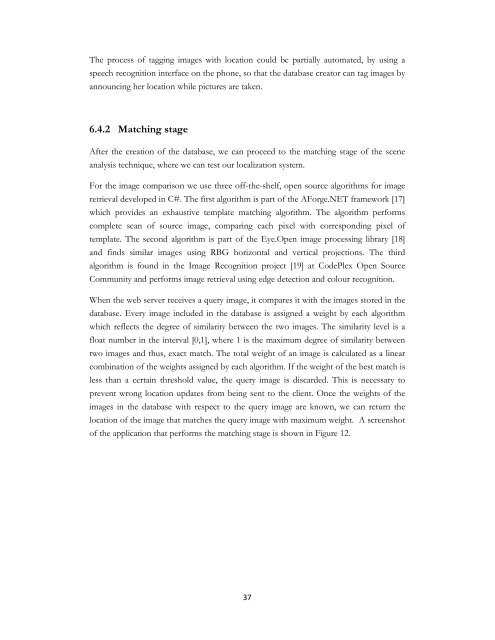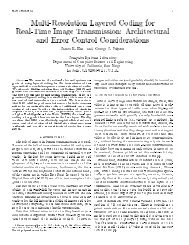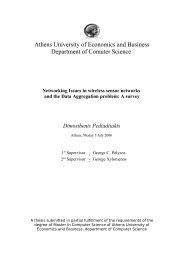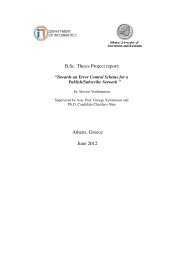The mobile phone as a platform for assisting the independent living ...
The mobile phone as a platform for assisting the independent living ...
The mobile phone as a platform for assisting the independent living ...
Create successful ePaper yourself
Turn your PDF publications into a flip-book with our unique Google optimized e-Paper software.
<strong>The</strong> process of tagging images with location could be partially automated, by using <strong>as</strong>peech recognition interface on <strong>the</strong> <strong>phone</strong>, so that <strong>the</strong> datab<strong>as</strong>e creator can tag images byannouncing her location while pictures are taken.6.4.2 Matching stageAfter <strong>the</strong> creation of <strong>the</strong> datab<strong>as</strong>e, we can proceed to <strong>the</strong> matching stage of <strong>the</strong> sceneanalysis technique, where we can test our localization system.For <strong>the</strong> image comparison we use three off-<strong>the</strong>-shelf, open source algorithms <strong>for</strong> imageretrieval developed in C#. <strong>The</strong> first algorithm is part of <strong>the</strong> AForge.NET framework [17]which provides an exhaustive template matching algorithm. <strong>The</strong> algorithm per<strong>for</strong>mscomplete scan of source image, comparing each pixel with corresponding pixel oftemplate. <strong>The</strong> second algorithm is part of <strong>the</strong> Eye.Open image processing library [18]and finds similar images using RBG horizontal and vertical projections. <strong>The</strong> thirdalgorithm is found in <strong>the</strong> Image Recognition project [19] at CodePlex Open SourceCommunity and per<strong>for</strong>ms image retrieval using edge detection and colour recognition.When <strong>the</strong> web server receives a query image, it compares it with <strong>the</strong> images stored in <strong>the</strong>datab<strong>as</strong>e. Every image included in <strong>the</strong> datab<strong>as</strong>e is <strong>as</strong>signed a weight by each algorithmwhich reflects <strong>the</strong> degree of similarity between <strong>the</strong> two images. <strong>The</strong> similarity level is afloat number in <strong>the</strong> interval [0,1], where 1 is <strong>the</strong> maximum degree of similarity betweentwo images and thus, exact match. <strong>The</strong> total weight of an image is calculated <strong>as</strong> a linearcombination of <strong>the</strong> weights <strong>as</strong>signed by each algorithm. If <strong>the</strong> weight of <strong>the</strong> best match isless than a certain threshold value, <strong>the</strong> query image is discarded. This is necessary toprevent wrong location updates from being sent to <strong>the</strong> client. Once <strong>the</strong> weights of <strong>the</strong>images in <strong>the</strong> datab<strong>as</strong>e with respect to <strong>the</strong> query image are known, we can return <strong>the</strong>location of <strong>the</strong> image that matches <strong>the</strong> query image with maximum weight. A screenshotof <strong>the</strong> application that per<strong>for</strong>ms <strong>the</strong> matching stage is shown in Figure 12.37








